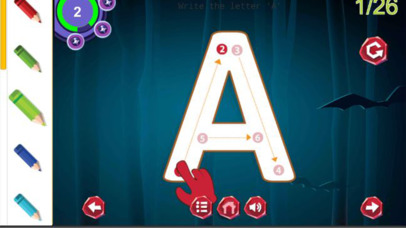
Zombie Alphabet Kids Tracing Book app for iPhone and iPad
Developer: Aduldet Wongngam
First release : 08 Feb 2017
App size: 188.88 Mb
A zombie (French Haiti: zombies, Haitian Creole: zonbi) is a fantastic undead created through the resuscitation of a human corpse. Zombies are more commonly found in horror and fantasy genre works. The term comes from Haitian folklore, where a zombie is a reanimated corpse through various methods, most commonly magic. Modern depictions of zombies does not necessarily involve magic, but science fiction often invoke methods such as radiation, mental illness, viruses, scientific accidents, etc. [1] [2]
One of the first books to expose the Western culture to the concept of voodoo zombies was the island of Magic W.B. Seabrook in 1929. This is the sensational story of a narrator who encounters voodoo cults of Haiti and their resurrected slaves. The time argued that the book "introduced zombies in the United States Item". [4]
Zombies have a complex literary heritage, with a history ranging from Richard Matheson and Howard Phillips Lovecraft in Mary Shelleys Frankenstein drawing European undead folklore. In 1932, Victor Halperin directed White Zombie, a horror film starring Bela Lugosi. Here the zombies are depicted as mindless, unconscious henchmen under the spell of an evil wizard. Zombies, often still with this logic voodoo-inspired, were initially rare in the cinema, but their appearances continued sporadically through 1930 to 1960, with major films including I Walked with a Zombie (1943) and Plan 9 from Outer Space (1959) .
A new version of zombies, distinct from that described in the Haitian folklore, also emerged in popular culture in recent decades. This "zombie" is drawn largely from the seminal film Night of the Living Dead George A. Romero, [1], which was in turn partly inspired by the 1954 novel by Richard Mathesons I Am Legend. [5] [6] The word zombie is not used in Night of the Living Dead, but was subsequently applied by fans. [7] The monsters of the film and its sequel, as Dawn of the Dead and Day of the Dead, as well as its many inspired works, such as the return of the Living Dead and Dawn of the Dead 2, are usually hungry for human flesh, although return of the living dead has introduced the popular concept of zombies eating brains. The concept of "Zombie Apocalypse", in which the civilized world is brought low by a global zombie infestation, has become a staple of modern folk art.
An alphabet is a standard set of letters (basic written symbols or graphemes) that is used to write one or more languages ??based on the general principle that the letters represent phonemes (basic significant sounds) of the spoken language. This is in contrast with other types of writing systems, such as syllabaries (in which each character represents a syllable) and logographies (in which each character represents a word, morpheme, or semantic unit).
The proto-Canaanite script, later known as



